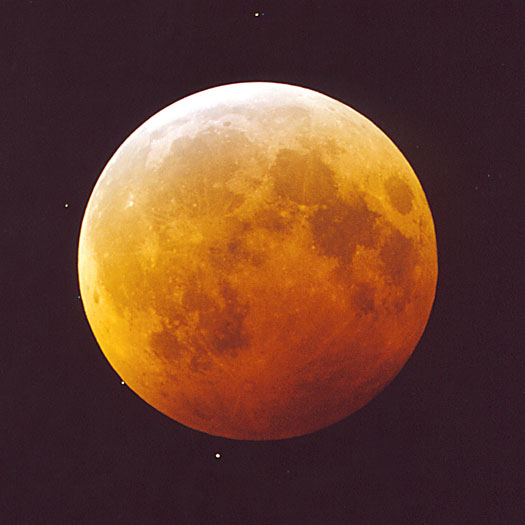
This page has been accessed times.


|
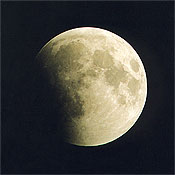
|
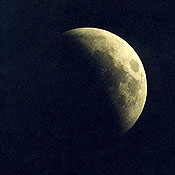
|
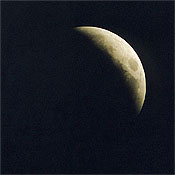
|
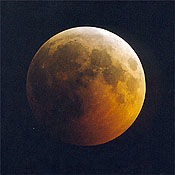
|
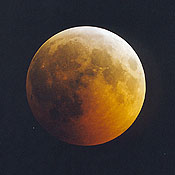
|
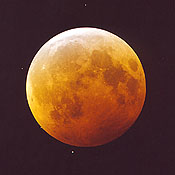
|
Please note: All times are in Universal Time (UT) unless otherwise stated. You should also be aware of the fact that the times given in this report are only approximate and the error may be on the order of several minutes. The second number below each picture is the exposure time.
Summary
During this eclipse the moon did not pass through or near the center of the shadow cast by the earth, which explains the great variation in brightness and colour between different parts of the moon during totality. As can be seen in the photographs above, the colour ranged from copper red to almost white. While this was a real treat for the eyes, it also made it difficult to estimate the correct exposure time for each picture. The moon was very close to some relatively bright stars in the constellation Gemini, adding to the beauty of the scenery.
However, the weather did not cooperate and clouds were constantly interfering. Following the end of totality it started to rain and I had to call it a night. As if that was not enough, my camera began to malfunction halfway through the eclipse. It refused to operate with the cable release and I missed several good opportunities. Photography was done through an 8" f/6.3 telescope and casual visual observing with a 5" f/6 telephoto lens/telescope.
If you have a general interest in astronomy and astrophotos, you may want to have a look at my main page.
Haven't had enough of eclipses for one day? Check out my photographic study of the often neglected penumbral lunar eclipses.
Some technical notes on the pictures:
| Location | Svalöv, Sweden, 13d06'41" E, 55d54'44" N |
| Optics | 8" Celestron SCT at f/6.3 with focal reducer/corrector |
| Mount | Vixen Super Polaris GEM tracking at sidereal rate |
| Camera | Canon FTb SLR with mirror lock |
| Film | Kodak Gold Ultra 400, film code GC |
| Processing | Local 1h mini lab |
| Scans | From 10X15 cm prints on an AGFA SnapScan 310 |
The long story
As seen from my backyard in Svalöv, Sweden, the total lunar eclipse of January 9, 2001 began when the moon entered the penumbra at about 17:43 and ended at 22:58. Although the penumbral stages, which occur at the beginning and the end of an eclipse, are indeed both interesting and possible to capture on film, I decided to concentrate on the umbral and total parts of this particular ecplise. In other words, my goal was to photographically document the ecplise between 18:41 and 21:59 with special attention paid during totality (19:49-20:52, maximum at 20:21).
One reason to skip the penumbral part was a desire to keep film consumption down to a single roll of 36 exposures. Besides, high buildings and trees would have made it impossible for me to follow the entire eclipse without relocating my telescope. Another reason was that I have already "been there, done that" when it comes to penumbral eclipses.
My initial plan was to begin shooting at 18:41 and then take one picture every 10 minutes until 19:41 to cover the first partial phase. That would require 7 exposures and the eclipse would be total at the next scheduled exposure.
Since it is very difficult to estimate exactly how bright the moon will be during totality, I meant to proceed from that point by taking one set of 3 pictures at 10 minute intervals: One picture with a guessed correct exposure time, a second picture one "stop" brighter and a third picture one stop darker. This is known as bracketing and is a cheap insurance against total failure. 3 pictures every 10 minutes from 19:51 to 20:51 would make for a total of 21 (3*7) frames.
Following the end of totality I planned to finish the session by taking 7 pictures of the second partial phase.
This would make for a total of 35 exposures.
However, things didn't turn out exacly as I had hoped. I estimate that clouds obscured the moon at least 85% of the time this evening. Luckily the clouds came and went and a typical cycle involved 2-3 minutes of clouds followed by 5-15 s of more or less clear view of the moon, but there were periods when it was cloudy for 15-20 minutes. I was actually quite happy about this situation. It might as well have been cloudy all night, and while it hampered my picture taking it allowed for some very nice, but brief, visual observing.
Anyhow, the weather ruined my general plan and I had to take pictures whenever I could. As mentioned in the summary I also experienced mechanical problems with my camera. At 21:00 it suddenly started to rain and I had to call it a night. It was a terrible experience to see it raining on all my equipment and I had to hurry like crazy to get it into the house.
The pictures above are the best I got from the 33 exposures made during the evening. As you can see from the time stamps in the table above the exposures are not evenly spaced. My timing was totally at the mercy of the clouds.
I normally like to put together an animation of every eclipse I photograph, but since I don't have a decent sequence of pictures still images will have to do this time.
As always, your comments and suggestions are welcome. Send e-mail to bengt@df.lth.se
Images and text copyright © 2001 Bengt Ask.